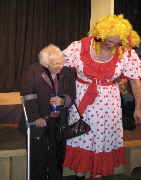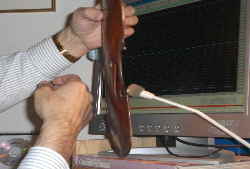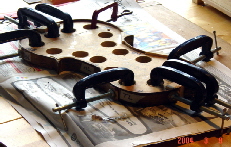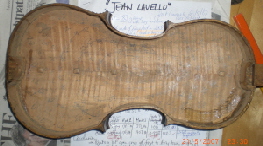|
Who am I?
My name's Jonathan, and I've been playing violin and lately viola as an amateur for much of 50 years now, and rebuilding violins and violas for 10 or more years. Over the last 3 or 4 years the odd violin or 2 for rebuilding has become the 30 or so - as I discovered eBay. Not one violin among them was a Strad: the labels were definitely lying.
I got an Engineering Degree from Cambridge in the early 1970's. First I trained as a teacher and taught secondary science and Physics for several years , and ever since then I've been working in electronics, telecoms and sales. , and ever since then I've been working in electronics, telecoms and sales.
Here's a picture of me, disguised as Pantomime Dame, with my mother-in-law Grannie Jones, who died this year, a couple of months after this was taken. Lovely lady: we miss her.
So what is the basis for claiming setting up tap-tones in front and back plates works?
Of the 30+ low-cost violins (and violas) I have, so far I've modified 8. These are of all sorts: a German Maggini copy, a JTL ‘Medio Fino' stamped ‘Steiner, a D Hopf copy bench fiddle (transitional *) of the early 1800's, a lions head German (transitional *) fiddle also early 1800's, a German Stainer copy, a 7/8ths Christian Meisel (1930), and a good Mittenwald, with very dark varnish that once had a severed peg-box. These violins now have a known, matched ‘stiffness factors' on front and back.
These first 8 do verify that Dr. Harris's ‘formula' really works, and can be applied to pretty much any violin to produce a fine sounding, playable instrument with a fairly predictable tone.
I have started to document them (see Example Violins) to show how the tone and playability was improved. It includes sound files too to give you some idea of the tone. I will show what is good, and what is not so good about them. There is a lot of work still to do.
* Meaning a short neck (about 10 mm short of standard) that I've had to lengthen.
|



